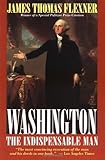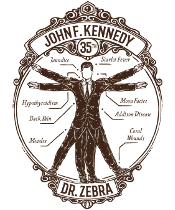

Health and Medical History of President
George WashingtonLived 1732-1799
Health and Medical History of President
George WashingtonLived 1732-1799
1776-1783
1812-1815
1846-1848
1861-1865
1898-1899
1917-1918
1941-1945
1950-1953
1964-1975
1990-1991
2001-2021

| UNDER CONSTRUCTION |
| Age Year Disease --- ---- ------- ?? ???? diphtheria 3 17 1749 malaria 19 1751 smallpox 19 1751 tuberculosis 30 1752 malaria 33 1755 dysentery (+) 35 1757 dysentery (*) 35 1757 tuberculosis (*) 39 1761 malaria (**) 39 1761 dysentery (**) | Age Year Disease --- ---- ------- 47 1779 quinsy 52 1784 malaria 57 1789 carbuncle 58 1790 pneumonia 59 1791 carbuncle 66 1798 malaria 67 1799 epiglottitis[?] | ||
| + =
multiple episodes * = simultaneous illnesses * * = simultaneous illnesses | |||
It was fortunate for the country that Washington's health was comparatively good during the Revolutionary War (1776-1783).
Later, as Commander in Chief of the Continental Army in the 1770s, Washington took an unprecedented step by insisting that no recruit could join the army until vaccinated against smallpox 4b 6a MORE.
It has been proposed that tuberculosis of the vas deferens caused Washington's sterility (below) and that tuberculosis of the gut caused his multiple episodes of bloody diarrhea (below) 7.
He may be described as being straight as an Indian, measuring 6 feet 2 inches in his stockings, and weighing 175 lbs when he took his seat in the House of Burgesses in 1759. His frame is padded with well developed muscles, indicating great strength. His bones and joints are large as are his hands and feet. He is wide shouldered but has not a deep or round chest; is neat waisted, but is broad across the hips, and has rather long legs and arms. His head is well shaped, though not large, but is gracefully poised on a superb neck. A large and straight rather than a prominent nose; blue-grey penetrating eyes which are widely separated and overhung by a heavy brow. His face is long rather than broad, with high round cheek bones, and terminates in a good firm chin. He has a clear tho rather colorless pale skin which burns with the sun. A pleasing and benevolent tho a commanding countenance, dark brown hair which he wears in a cue. His mouth is large and generally firmly closed, but which from time to time discloses some defective teeth. His features are regular and placid with all the muscles of his face under perfect control, tho flexible and expressive of deep feeling when moved by emotions. In conversation he looks you full in the face, is deliberate, deferential and engaging. His demeanor at all times composed and dignified. His movements and gestures are graceful, his walk majestic, and he is a splendid horseman.
After his death, Washington's frozen corpse was measured as 6 feet 3.5 inches in length 3a. The body was 1 foot 9 inches across at the shoulders and at the elbows. Another reference cites Washington as 6 feet 2 inches tall 9a. Comment: A post-mortem frozen height would be greater for at least two reasons: (1) If the corpse really was frozen, a frozen Washington would be taller because our bodies are 70% water and because water expands as it freezes -- the only liquid with this property. (2) A laid-out corpse would be relieved of gravity pressing on the spine. As astronauts know, people "grow" a few inches when weight on the spine is removed.
On July 9, "the most catastrophic [day] in all Anglo-American history," Washington was so ill that he had to tie pillows to his saddle in order to ride his horse. As the army rode through a 12-foot-wide road cleared through the thick woods, the French and their Indian allies engaged the English, firing unseen from the surrounding trees. The English regulars, accustomed to fighting on open ground in formation, panicked, and the carnage began. "Braddock indignantly denied Washington's request to lead troops into the woods and `engage the enemy in their own way'" 4c.
The officers, perfect targets atop their horses, went down in succession. Washington had two horses shot out from under him. Braddock crumpled. Washington's hat was shot off. Bullets tore his coat. Washington was left as the only person able to distribute the wounded general's orders, and led the retreat. Somehow Washington was then able to ride 40 miles through darkness to summon reinforcements, though he occasionally had to crawl on his hands and knees to find the road. He later admitted that the ride left him "in a manner wholly unfit for the execution of the duty" 4c.
Braddock died, and Washington staggered home to Mount Vernon on July 25, "weak and feeble" 4c. He continued to have attacks of fever and dysentery the rest of the year. In 1757 he had a severe recurrence of dysentery, accompanied by fever and pleurisy. He became "acutely and dangerously" ill from dysentery (and malaria) in 1761 2e. Less severe attacks continued 2c.
Tuberculosis of the gut has been blamed for these episodes of "dysentery" 7.
it could well be concluded that the difficulty was not in her but in her husband. However, [Washington,] the magnificent athlete, who possessed in abundance every other physical prowess, could not altogether admit to himself that he was sterile. He believed, even when approaching old age, that if Martha died and he became remarried to a "girl," he might father an heir. In the meanwhile, his lack was a grievous one. 4dGiven the way the Custis children turned out MORE, Washington may have been lucky. The United States may have been lucky, too. The lack of an heir made it difficult to anoint Washington as King, which some elements favored at the time 11a. There is speculation that the lack of an heir made it difficult for Washington to accept an offer of Kingship 9b.
Washington's height, sterility, large hands, pockmarks, plus certain personality features and even his dental problems have led to the suggestion he had a syndrome associated with an XYY chromosome karyotype 9c. A geneticist concludes, however, "although there does seem to be a strong case that George Washington was affected with XYY syndrome, the evidence is just not conclusive" 9b. There are also speculations 12 -- dismissed by some 7 -- that Washington had Klinefelter syndrome, which is associated with an XXY karyotype. At least one historian believes that Martha was the cause of the marriage's childlessness 13, but his reasoning is unsupported and arrogant MORE.
I have, myself, experienced the fruits of his skill, in this art; being cured by him of an irritable spot on my right cheek which had for years been increasing in pricking and disagreeable sensations; and in June last assumed the decided character of a Cancer; of which I was perfectly relieved by Doctr. Tate in about two months by an easy course, under the operation of which I felt no confinement, or other inconvenience at that time, nor any injury to my constitution since. 17Modern commentators speculate that the lesion might have been an actinic keratosis which underwent an acute solar degeneration. They also speculate that the treatment was most likely repeated application of an escharotic or paste. 17
Washington's clumsy, ill-fitting dentures distorted his lips. This contributed to the dour expression Washington has in various portraits 2j. Also, painter Gilbert Stuart disliked Washington and accentuated the distortion in what became the most famous of all Washington portraits 11b. The Peale portrait of 1776 shows a long scar along Washington's left cheek. This resulted from an incision to treat an abscessed tooth 2j.
First suggested in 1838, most authorities today believe Washington's final illness was acute bacterial epiglottitis 3 -- an infection of the small tissue flap that plugs the entrance to the lungs during swallowing. Since the invention of antibiotics, this infection has become rare, but even now its occurrence is exceedingly serious. When the epiglottis swells (as it will do in response to an infection) it can block airflow into the lungs -- an obviously fatal outcome.
The bleedings inflicted by Washington's doctors hastened his end. Some 80 ounces of blood were removed in 12 hours 3 (this is .63 gallons, or about 35% of all the blood in his body).
A British physician of the era, John Reid, estimated that up to 90 ounces had been removed, and sarcastically remarked that the "current of blood" drained from Washington reflected the mighty currents of American rivers. 20! Reid also criticized the heavy dosing of calomel plus the administration of emetics, vinegar vapors, and blistering to a man in his late 60s.
One of the three doctors atteding Washington, Elisha Cullen Dick, objected to continued bleeding, arguing instead for tracheotomy. Tracheotomy is a surgical procedure recognized today as potentially life-saving in epiglottitis, but was then almost unworkable. Dick was overruled by the senior physician, James Craik. "Undoubtedly, the specter of failure with a grisly, painful (in the absence of anesthesia), and untried surgical experiment on the former president weighed heavily in Craik's decision to veto this radical suggestion" 3. (It should also be remembered that "former president" does not begin to describe Washington's stature. He was the most famous man in the world, for 20 years the pre-eminent man in American life, and was held in almost religious esteem by his countrymen.)
A detailed description of Washington's agonizing final hours survives MORE.
Thornton "proposed that the body be thawed gradually, first in cool water and then with warm blankets and rubbing of the skin, with the subsequent performance of a tracheotomy, artificial respiration at the tracheotomy site, and transfusion of lamb's blood" 3.
Martha Washington vetoed the plan. Interestingly, Washington had once revived a slave thought to be dead 3.
- Abraham Lincoln told the following physiological anecdote about Washington, which he attributed to Colonel Ethan Allen, a hero of the American Revolution. During a post-war visit to England, Allen's hosts took great pleasure in ridiculing Americans, particularly George Washington. To irritate Allen they went so far as to hang a picture of Washington in the "Back House" (toilet). Allen announced this was highly appropriate, because "there is nothing that will Make an Englishman Shit so quick as the sight of Genl Washington" 21a.
- The FBI has information about Washington's DNA. In 1994 the Daughters of the American Revolution wanted to verify the genuiness of several purported locks of Washington's hair. The DAR located a female descendant of Washington's mother, and took a sample from her to analyze for mitochondrial DNA. (Normally, only the mother passes mitochondrial DNA to her children, so this woman's mitoDNA should be the same as Washington's.) The sample was given to the FBI Forensic Research and Training Center in Quantico, Virginia 22.
- White McKenzie Wallenborn, M.D., a retired professor of otoloaryngology at the University of Virginia, compiled a short list of pre-Medline references to Washington's medical history 23 MORE.
- Through several lines of ancestry, Washington can trace descent from English royalty. His famous relatives, albeit distant, include King Edward I, Queen Elizabeth II, Sir Winston Churchill, and General Robert E. Lee 10b. At one time it was erroneously thought that Washington and James Madison were distant cousins 10b.
- Henriques, Peter R. The Death of George Washington: He Died as He Lived. Mt. Vernon, VA: The Mount Vernon Ladies' Association, 2000.
 a p. vi (introduction by Philander D. Chase)
a p. vi (introduction by Philander D. Chase) - Bumgarner, John R. The Health of the Presidents: The 41 United States Presidents Through 1993 from a Physician's Point of View. Jefferson, NC: MacFarland & Company, 1994.
 a pp.1-8 b pp.1, 4, 6 (year might have been 1786) c p.4 d p.1 e p.3 f p.2 g pp.3, 4 h pp.4-5 i pp.5-6 j p.6
a pp.1-8 b pp.1, 4, 6 (year might have been 1786) c p.4 d p.1 e p.3 f p.2 g pp.3, 4 h pp.4-5 i pp.5-6 j p.6Comment: Devotes one chapter to each President, through Clinton. Written for the layperson, well-referenced, with areas of speculation clearly identified, Dr. Zebra depends heavily on this book. Dr. Bumgarner survived the Bataan Death March and has written an unforgettable book casting a physician's eye on that experience.
- Morens DM. Death of a President. New Engl J Med. 1999:341;1845-1849. Pubmed: 10588974.
a Tobias Lear recorded these measurements in his journal. He does not say the corpse was frozen.
- Flexner, James Thomas. Washington: The Indispensible Man. Boston: Little, Brown, 1974.
 a p.8 b p.132 c p.24 d p.42 e p.198 f pp.165-175
a p.8 b p.132 c p.24 d p.42 e p.198 f pp.165-175Comment: Distillation of Flexner's four-volume biography of Washington published from 1965 to 1972.
- Kar JK, Phadke AM. Vaso-epididymal anastomosis. Fertil Steril. 1975; 26: 743-756. Pubmed: 1157961.
- Gabriel, Richard A.; Metz, Karen S. A History of Military Medicine, Volume 2. Westport, CT: Greenwood Press, 1992.
 a p.108
a p.108 - Amory JK. George Washington's infertility: why was the father of our country never a father?. Fertility and Sterility. 2004; 81: 495-499.
Comment: Reviews the differential diagnosis of Washington's sterility, and identifies genitourinary tuberculosis as the most probably cause. Fails to consider smallpox as a possible cause. Also identifies enteric tuberculosis as a possible cause of Washington's recurrent "dysentery," and expresses skepticism that he had Klinefelter syndrome.
- U.S. National Archives and Records Administration. Resolution of the House of Burgesses, 26 February 1759. Available on the web: http://founders.archives.gov/documents/Washington/02-06-02-0156
Comment: Checked on 2014-11-29.
- Marion, Robert. Was George Washington Really the Father of our Country?. Reading, MA: Addison-Wesley, 1994.
 a p.67 b p.72 c pp.41-74
a p.67 b p.72 c pp.41-74 - Montgomery-Massingberd, Hugh (ed). Burke's Presidential Families of the United States of America. 2nd ed. London: Burke's Peerage Limited, 1981.
 a p.16 b p.45
a p.16 b p.45Comment: Maps -- in great detail -- the ancestors and descendants of American presidents through Ronald Reagan. They would have had an exhausting time with President Obama's family tree! MORE
- Boller, Paul F. Jr. Presidential Anecdotes. New York: Oxford University Press, 1981.
 a pp.13-14 b p.6
a pp.13-14 b p.6 - Smith, MJV. The father who was not a father. Virginia Medical Monthly. 1976;103:14-16, 21-22, 33. Pubmed: 1106028.
- Harden B. First President's childlessness linked to disease. Washington Post. Feb. 29, 2004; A3.
- Dugan, James. Bedlam in the boudoir. Colliers. 22 Feb. 1947; pages 17, 69-70.
Comment: Credibility is dubious. Just before a list of Presidents, the article states: "Twenty of the 32 Presidents ... are proved or believed on a thick web of circumstance to have been nocturnal nuisances in the White House."
- Blinderman A. George Washington's health. NY State Med J. 1975;75:122-132. Pubmed: 1089222.
- MacMahon, Edward B. and Curry, Leonard. Medical Cover-Ups in the White House. Washington, DC: Farragut, 1987.
 a pp.15-16
a pp.15-16 - Hayes H, Talbert G. The facial lesion of George Washington. Plast Reconstructive Surg. 1987;80:133-136. Pubmed: 3299417.
- Cooper, Pauline. The Medical Detectives. New York: David McKay, 1973.
 a p.96
a p.96 - Available on the web: http://www.virginia.edu/gwpapers/faq/gwteeth.html
Comment: Picture of a set of Washington's dentures, complete with springs.
- Morgan LK. The final medical treatment of two American presidents. Med J Australia. 1969:;880-881.
Comment: Cites The Medical and Physical Journal 1800;3:473.
- Donald, David Herbert. Lincoln. New York: Touchstone / Simon & Schuster, 1996.
 a pp.38-39
a pp.38-39Comment: Widely regarded as the best one-volume biography of Lincoln, covering his entire life.
- Grusin, Sarah. The root of the matter. Washington Post Magazine. Feb. 27, 1994;9.
Comment: Part of the "J Street" column.
- Wallenborn, White McKenzie. George Washington's terminal illness: a modern medical analysis of the last illness and death of George Washington. [on line]. 31 March 1999.
Comment: From the papers of George Washington at the University of Virginia. Accessed 17 December 2002 at: http://www.virginia.edu/gwpapers/articles/wallenborn/index.html
















